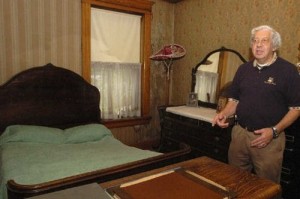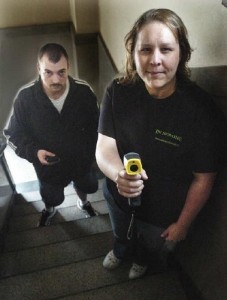
Clark Valentine, owner of The Pfeiffer House, describes some of the mysterious activity that has occurred at the century-old downtown home. Paranormal researchers also observed unexplained phenomena.
Apparitions of small children, pianos playing by their own accord and ghostly lights are all part of this report. The Indiana Paranormal Research Society talk about the equipment they use, the cases they’ve done and the perils of ghost hunting.
Fort Wayne – Things do go bump in the night. Figuring out what made those bumps, however, can be a little complicated.
Complicated, say Fort Wayne’s ghost hunters, but usually not impossible.
“Sometimes the demons are in their head,” says Chuck Sosbe, co-founder of the Indiana Society of Paranormal Research. “It’s like, ‘I’m sorry, lady, but you need a therapist, not a priest.’ ”
Despite their fascination with the unexplained, modern ghost hunters do not think every shadow is the ghost of old Aunt Mildred. Nor are they the crew of “Ghost Busters,” searching for ectoplasmic residue and battling giant marshmallow men. In fact, most of them will tell you they don’t know what paranormal activity is. The ghost hunters consider themselves instead to be investigators.
Members of the society will meet more people with spooky interests at Paranormacon, Fort Wayne’s first paranormal conference, hosted by local paranormal investigators, In Nomine Paranormal Research.
Held Saturday and Sunday at the Fort Wayne Masonic Temple, the conference should draw between 200 and 400 people from around the Midwest, says Rob Stone, who’s in charge of Paranormacon.
Conference topics will range from exorcism to “The Reluctant Ghost Hunter” and “Putting the Normal Back in Paranormal.”
Brian Harnois, who was on the SciFi Channel’s “Ghost Hunters,” is giving a one-hour seminar, “Ghost Hunting 301,” dealing with some of the equipment used when hunting ghosts. Harnois will also go on a ghost hunt through the Masonic Temple, which some say is haunted.
A movie about a haunted home, “The Sallie House,” will have its premiere, and Architecture & Community Heritage will offer a “Fright Sites” walking tour.
Most proceeds made from conference registrations will go to help preserve the Masonic Temple. Tickets range from $18 for both days to the Ghost Hunter VIP Pass for $135, which gets you every class and seminar, a book, T-shirt, dinner, front-row seating and two ghost-hunting investigations. As of Wednesday, there were only four VIP passes left.
Skeptical? That’s OK – the members of the paranormal research teams are skeptical, too.
“I can’t see radar, but I know it exists. I can’t see God, but I know he exists,” says Ravenwolfe Teu, Indiana Society of Paranormal Research’s shaman. “Trying to explain it is impossible, but people genuinely believe they’re having these experiences, and I think that’s what matters.”
‘Spiritual unrest’?
Photos by Cathie Rowand | The Journal Gazette
Sarah Neher and Jason Snyder belong to the In Nomine Paranormal Research group.
In Nomine has investigated 12 or 15 cases of potential hauntings since its inception about a year ago. Most have turned out to be nothing supernatural.
Two, maybe three, however, are a different story.
In one, a home in Roanoke, the research team recorded EVPs, or electronic voice phenomena. When ghosts speak, audio recordings can pick up voices that human ears cannot, Stone says.
The area around the Roanoke home was once Miami Indian territory, and Stone thinks it’s possible that the Roanoke home is on an Indian burial ground.
“There might be some spiritual unrest there,” he says.
There may also be some unrest in the Pfeiffer House restaurant in downtown Fort Wayne, too.
The massive house at the corner of Wayne Street and Fairfield Avenue, built in 1905, has been host to unexplained things such as a salt shaker in the middle of a table suddenly falling on the floor, a slow-cooker lid falling over when there’s no one near it, and a single note sounding on the piano when there’s no one playing, owner Clark Valentine says.
One time, his daughter videotaped an upstairs light turning on when there was no one upstairs; another time, Clark saw the image of a small girl. It is believed that a little girl died of a broken back in the home in 1942.
When the Indiana Society of Paranormal Research team investigated, unexplained things started happening almost immediately.
As the research team set up a video camera, a door started to close by itself. In another room, team members saw a shadow move. In another, the air became thick and smelled like baby powder.
When team members listened to the audio recordings later, they heard things they hadn’t heard when they were present: A voice seemed to say, “You can’t see me” and “Oh, my goodness.” A video camera showed shadows of people as they walked up the stairs, but then another shadow completely covered the lens before disappearing.
Still, as the research team presented its findings to the Valentines, the members were skeptical, even of the video.
“I want to come back and see if we can duplicate it,” Walker says. “I bet we can. So right now, it’s just unexplained.”
Debunking mythsBoth groups take a scientific approach to studying paranormal activity. In fact, In Nomine recently debunked a popular local belief: The Waynedale Witch.
The legend is that a grave in Waynedale had strange phenomena connected to it. When photos were taken of the tombstone, a rose is visible, even though there’s none engraved there. Also, a green mist sometimes appears over the grave.
But In Nomine’s investigation found that the stone easily reflects flowers lying in front of it, and that the grave is in a humid area of the cemetery. It also found no evidence of the deceased being a witch. Church records, in fact, suggest she was not.
Both groups do their investigations for free, and both say their only real interest is lending a hand.
“What we’re doing is helping,” In Nomine’s Stone says. “We all have our day jobs and families. We want to help people, especially if it’s a situation where there’s not something paranormal happening.”
Some buildings can have strong electrical fields, which can cause seemingly inexplicable occurrences. High levels of carbon monoxide can do the same. Both can be dangerous. In the former instance, people can experience headaches and fatigue, Stone says; in the latter, death.
And sometimes, just sometimes, those strange bumps in the night are explained by paranormal activity. Well, if you believe in that stuff. Stone says he’s experienced it, and sometimes he still has trouble believing it.
The first time something inexplicable happened to him, he was a boy, maybe 12 or 14 years old. He saw a photo of his great-grandmother, a woman he had never met. But he remembered her.
About 10 years previously, he had had an imaginary friend. He didn’t remember the imaginary friend, but he knew his parents always talked about the friend Stone would talk to sometimes.
When he saw the photo of his great-grandmother, however, he remembered – she was the imaginary friend.
“I would go on the front porch, and my parents would come out, and I would be talking to someone,” he said. Seeing the picture, “kind of tripped me out a little bit. All the memories came flooding back.”
‘Hell breaks loose’Harnois, the former “Ghost Hunters” investigator, says he saw his first ghost when he was 11. He was in a friend’s room, and a full-body apparition walked through.
In the 17 years Harnois has been involved in ghost hunting, he’s seen a lot more. The scariest, he says, were a few exorcisms he’s attended, complete with eyes turning black and victims speaking different languages they don’t know.
“I’ve been there when all hell breaks loose,” he said. “Literally.”
What makes these instances scariest for Harnois, he says, is that humans are involved; a human can harm another human, whereas a spirit can’t. Sure, one can get your attention by throwing a penny or a cigarette lighter, but Harnois is not aware of any instance where a spirit has picked up a knife or a gun to harm someone.
But there are many people who say there has never been any real evidence of a “spirit” at all.
Benjamin Radford, managing editor of the Skeptical Inquirer and a debunker of ghost stories, said ghost hunters try to lend themselves legitimacy by calling themselves skeptics and saying they use scientific methods in their investigations.
“Whether the topic is Big Foot or UFOs, everyone likes to call themselves a skeptic. Sometimes they are, more often they’re not,” Radford said.
“They like to present themselves as using science, and on occasion they do discredit or debunk a report. But then they go to a supposedly haunted place, … and they throw science out the window.”
Radford said EVPs are simply your mind trying to interpret sounds into something meaningful, the same way people see Jesus in a tortilla or the Virgin Mary in a road salt pattern. And those “orbs” – glowing shapes that appear in photos – are caused by camera flashes.
The fact that neither are revealed until later only makes them seem more mysterious.
“So then it ties in with this notion that somehow with science and a $50 camera, the person is seeing into the other world,” Radford said.
So when the teams’ video cameras record strange shadows or floating orbs, or their audio recorders catch voices unheard by the human ear, what do they think it is? Is it spirits? Is it just electronic interference?
Or is it something else?
“All we can do is record the evidence,” says Walker, of the Indiana Society of Paranormal Research, “and say, ‘Here it is.’ ”
Full source: Journal Gazette





